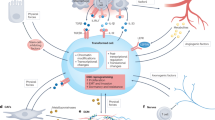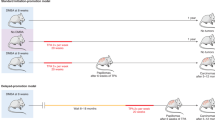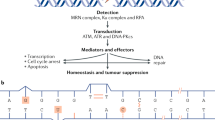Abstract
Recent research has highlighted a strong correlation between tissue-specific cancer risk and the lifetime number of tissue-specific stem-cell divisions. Whether such correlation implies a high unavoidable intrinsic cancer risk has become a key public health debate with the dissemination of the ‘bad luck’ hypothesis. Here we provide evidence that intrinsic risk factors contribute only modestly (less than ~10–30% of lifetime risk) to cancer development. First, we demonstrate that the correlation between stem-cell division and cancer risk does not distinguish between the effects of intrinsic and extrinsic factors. We then show that intrinsic risk is better estimated by the lower bound risk controlling for total stem-cell divisions. Finally, we show that the rates of endogenous mutation accumulation by intrinsic processes are not sufficient to account for the observed cancer risks. Collectively, we conclude that cancer risk is heavily influenced by extrinsic factors. These results are important for strategizing cancer prevention, research and public health.
This is a preview of subscription content, access via your institution
Access options
Subscribe to this journal
Receive 51 print issues and online access
$199.00 per year
only $3.90 per issue
Buy this article
- Purchase on Springer Link
- Instant access to full article PDF
Prices may be subject to local taxes which are calculated during checkout




Similar content being viewed by others
References
Sell, S. Stem cell origin of cancer and differentiation therapy. Crit. Rev. Oncol. Hematol. 51, 1–28 (2004)
Reya, T., Morrison, S. J., Clarke, M. F. & Weissman, I. L. Stem cells, cancer, and cancer stem cells. Nature 414, 105–111 (2001)
Cairns, J. Mutation selection and the natural history of cancer. Nature 255, 197–200 (1975)
Visvader, J. E. Cells of origin in cancer. Nature 469, 314–322 (2011)
Tomasetti, C. & Vogelstein, B. Variation in cancer risk among tissues can be explained by the number of stem cell divisions. Science 347, 78–81 (2015)
Ashford, N. A. et al. Cancer risk: role of environment. Science 347, 727 (2015)
Wild, C. et al. Cancer risk: role of chance overstated. Science 347, 728 (2015)
Potter, J. D. & Prentice, R. L. Cancer risk: tumors excluded. Science 347, 727 (2015)
Gotay, C., Dummer, T. & Spinelli, J. Cancer risk: prevention is crucial. Science 347, 728 (2015)
Song, M. & Giovannucci, E. L. Cancer risk: many factors contribute. Science 347, 728–729 (2015)
O’Callaghan, M. Cancer risk: accuracy of literature. Science 347, 729 (2015)
Tomasetti, C. & Vogelstein, B. Cancer risk: accuracy of literature—response. Science 347, 729–731 (2015)
Altenberg, L. Statistical problems in a paper on variation in cancer risk among tissues, and new discoveries. Preprint at http://arxiv.org/abs/1501.04605 (2015)
Torre, L. A. et al. Global cancer statistics, 2012. CA Cancer J. Clin. 65, 87–108 (2015)
Gray, J., Evans, N., Taylor, B., Rizzo, J. & Walker, M. State of the evidence: the connection between breast cancer and the environment. Int. J. Occup. Environ. Health 15, 43–78 (2009)
Shimizu, H. et al. Cancers of the prostate and breast among Japanese and white immigrants in Los Angeles County. Br. J. Cancer 63, 963–966 (1991)
Haggar, F. A. & Boushey, R. P. Colorectal cancer epidemiology: incidence, mortality, survival, and risk factors. Clin. Colon Rectal Surg. 22, 191–197 (2009)
Johnson, I. T. & Lund, E. K. Review article: nutrition, obesity and colorectal cancer. Aliment. Pharmacol. Ther. 26, 161–181 (2007)
Parkin, D. M., Mesher, D. & Sasieni, P. 13. Cancers attributable to solar (ultraviolet) radiation exposure in the UK in 2010. Br. J. Cancer 105 (Suppl 2), S66–S69 (2011)
Koh, H. K., Geller, A. C., Miller, D. R., Grossbart, T. A. & Lew, R. A. Prevention and early detection strategies for melanoma and skin cancer. Current status. Arch. Dermatol. 132, 436–443 (1996)
Blot, W. J. et al. Smoking and drinking in relation to oral and pharyngeal cancer. Cancer Res. 48, 3282–3287 (1988)
Kamangar, F., Chow, W.-H., Abnet, C. & Dawsey, S. Environmental causes of esophageal cancer. Gastroenterology Clin. North Am. 38, 27–57 (2009)
Bosch, F. X. et al. Prevalence of human papillomavirus in cervical cancer: a worldwide perspective. J. Natl. Cancer Inst. 87, 796–802 (1995)
Frisch, M. et al. Sexually transmitted infection as a cause of anal cancer. N. Engl. J. Med. 337, 1350–1358 (1997)
Chaturvedi, A. K. et al. Human papillomavirus and rising oropharyngeal cancer incidence in the United States. J. Clin. Oncol. 29, 4294–4301 (2011)
El-Serag, H. B. Epidemiology of viral hepatitis and hepatocellular carcinoma. Gastroenterology 142, 1264–1273 (2012)
Helicobacter and Cancer Collaborative Group. Gastric cancer and Helicobacter pylori: a combined analysis of 12 case control studies nested within prospective cohorts. Gut 49, 347–353 (2001)
Surveillance, Epidemiology, and End Results (SEER) Program. SEER*Stat Database: Incidence—SEER 9 Regs Research Data, Nov 2014 Sub (1973–2012) (National Cancer Institute, DCCPS, Surveillance Research Program, Surveillance Systems Branch, 2015)
Dela Cruz, C. S., Tanoue, L. T. & Matthay, R. A. Lung cancer: epidemiology, etiology, and prevention. Clin. Chest Med. 32, 605–644 (2011)
Alexandrov, L. B. & Stratton, M. R. Mutational signatures: the patterns of somatic mutations hidden in cancer genomes. Curr. Opin. Genet. Dev. 24, 52–60 (2014)
Alexandrov, L. B. et al. Signatures of mutational processes in human cancer. Nature 500, 415–421 (2013)
Jones, S. et al. Comparative lesion sequencing provides insights into tumor evolution. Proc. Natl Acad. Sci. USA 105, 4283–4288 (2008)
Tomasetti, C., Vogelstein, B. & Parmigiani, G. Half or more of the somatic mutations in cancers of self-renewing tissues originate prior to tumor initiation. Proc. Natl Acad. Sci. USA 110, 1999–2004 (2013)
Bozic, I. & Nowak, M. A. Unwanted evolution. Science 342, 938–939 (2013)
Tomasetti, C., Marchionni, L., Nowak, M. A., Parmigiani, G. & Vogelstein, B. Only three driver gene mutations are required for the development of lung and colorectal cancers. Proc. Natl Acad. Sci. USA 112, 118–123 (2015)
Acknowledgements
We thank L. Obeid for constructive comments. This work was supported in part by NCI grants 97132 and 168409 and Stony Brook NYSTEM award C026716.
Author information
Authors and Affiliations
Contributions
Y.A.H. formulated the hypothesis. S.W. and Y.A.H. designed the research. S.W. and W.Z. performed mathematical and statistical analysis. S.W., S.P., W.Z. and Y.A.H. performed research. S.W., S.P., W.Z. and Y.A.H. wrote the paper.
Corresponding authors
Ethics declarations
Competing interests
The authors declare no competing financial interests.
Extended data figures and tables
Extended Data Figure 1 Examples of increased cancer incidence trends from 1973–2012 in SEER data.
The cancer types include melanoma, thyroid cancer, kidney cancer, liver cancer, small intestine cancer, testicular cancer, non-Hodgkin lymphoma (NHL), anal and anorectal cancer and thymus cancer. The horizontal dashed lines indicate the historical minimal incidence. The vertical solid lines indicate the most recent year. The numbers represent the minimal percentage of extrinsic risk. The cervix uteri cancer, gallbladder cancer and oesophageal cancer are examples with declining or consistent incidence trend. The incidence rate is per 100,000 people.
Extended Data Figure 2 Sensitivity analysis of different mutation rates on tLIR when the number of hits (k) required is 3.
a, b, Theoretical intrinsic lifetime risks (tLIR) for cancers have been calculated based on five different mutation rates: r = 1 × 10−10, 1 × 10−9, 1 × 10−8, 1 × 10−7, 1 × 10−6. The red dashed lines are the ‘intrinsic’ risk lines based on the observed data following the same estimation mechanism as the intrinsic risk line in Fig. 3a. The green (a) and blue (b) dashed lines are the ‘intrinsic’ risk lines estimated based on total reported stem-cell numbers and total homeostatic tissue cells, respectively.
Extended Data Figure 3 Sensitivity analysis of different mutation rates on tLIR when the number of hits (k) required is 4.
a, b, Theoretical intrinsic lifetime risks (tLIR) for cancers have been calculated based on five different mutation rates: r = 1 × 10−10, 1 × 10−9, 1 × 10−8, 1 × 10−7, 1 × 10−6. The red dashed lines are the ‘intrinsic’ risk lines based on the observed data following the same estimation mechanism as the intrinsic risk line in Fig. 3a. The green (a) and blue (b) dashed lines are the ‘intrinsic’ risk lines estimated based on total reported stem-cell numbers and total homeostatic tissue cells, respectively.
Extended Data Figure 4 Intrinsic cancer risk modelling.
Part 1 of 2: propagation diagram of driver gene mutation states between generations in one stem cell, from which the stem-cell mutation transition probabilities from one generation to the next are computed.
Extended Data Figure 5 Intrinsic cancer risk modelling.
Part 2 of 2: schema of stem-cell divisions and driver gene mutations, from which the theoretical lifetime intrinsic risks (tLIR) for cancer due to k driver gene mutations are computed. Each coloured circle represents the mutation of a new driver gene in the given stem cell (yellow, first mutation; green, second mutation; red, third mutation). If the mutation of 3 designated driver genes would induce a cancerous stem cell (k = 3), then this diagram shows a cancer occurrence as the second stem cell in the last generation (generation n) that has accumulated all 3 driver gene mutations.
Supplementary information
Supplementary Information
This file contains Supplementary Text and Data and additional references. (PDF 198 kb)
Rights and permissions
About this article
Cite this article
Wu, S., Powers, S., Zhu, W. et al. Substantial contribution of extrinsic risk factors to cancer development. Nature 529, 43–47 (2016). https://doi.org/10.1038/nature16166
Received:
Accepted:
Published:
Issue Date:
DOI: https://doi.org/10.1038/nature16166
This article is cited by
-
Cancer hallmark analysis using semantic classification with enhanced topic modelling on biomedical literature
Multimedia Tools and Applications (2024)
-
Initiation of Cancer: The Journey From Mutations in Somatic Cells to Epigenetic Changes in Tissue-resident VSELs
Stem Cell Reviews and Reports (2024)
-
Modeling of Mouse Experiments Suggests that Optimal Anti-Hormonal Treatment for Breast Cancer is Diet-Dependent
Bulletin of Mathematical Biology (2024)
-
Deer antlers: the fastest growing tissue with least cancer occurrence
Cell Death & Differentiation (2023)
-
Genome-wide enhancer-gene regulatory maps link causal variants to target genes underlying human cancer risk
Nature Communications (2023)
Comments
By submitting a comment you agree to abide by our Terms and Community Guidelines. If you find something abusive or that does not comply with our terms or guidelines please flag it as inappropriate.



